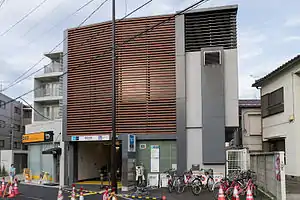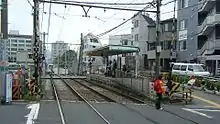Zoshigaya Station
Zoshigaya Station (雑司が谷駅, Zōshigaya-eki) is a subway station on the Tokyo Metro Fukutoshin Line in Toshima, Tokyo, Japan, operated by the Tokyo subway operator Tokyo Metro. It is numbered "F-10".
F10 Zoshigaya Station 雑司が谷駅 | |||||||||||
|---|---|---|---|---|---|---|---|---|---|---|---|
 Entrance No. 1 in July 2012 | |||||||||||
| Location | 2-6-1 Zoshigaya, Toshima-ku, Tokyo 171-0032 Japan | ||||||||||
| Operated by | |||||||||||
| Line(s) | F Tokyo Metro Fukutoshin Line | ||||||||||
| Distance | 13.1 km from Wakoshi | ||||||||||
| Platforms | 1 island platform | ||||||||||
| Tracks | 2 | ||||||||||
| Connections | Kishibojimmae (Toden Arakawa Line) | ||||||||||
| Other information | |||||||||||
| Station code | F-10 | ||||||||||
| Website | www | ||||||||||
| History | |||||||||||
| Opened | 14 June 2008 | ||||||||||
| Passengers | |||||||||||
| FY2015 | 17,437 daily | ||||||||||
| Services | |||||||||||
| |||||||||||
| Location | |||||||||||
 Zoshigaya Station Location within Japan | |||||||||||
Lines
Zoshigaya Station is served by the Tokyo Metro Fukutoshin Line between Wakoshi and Shibuya, with many direct through-running services to and from the Seibu Ikebukuro Line and Tobu Tojo Line in the north, and the Tokyu Toyoko Line and Minatomirai Line in the south.
The station is adjacent to Kishibojimmae Station on the Toden Arakawa Line. To prevent confusion, the former Zōshigaya Station on the Arakawa Line was renamed Toden-Zōshigaya when the Fukutoshin Line opened in 2008.
Station layout
The station consists of one underground island platform located on the fourth basement ("4BF") level, serving two tracks.
Platforms
| 1 | F Tokyo Metro Fukutoshin Line | for Shinjuku-sanchome and Shibuya TY Tokyu Toyoko Line for Jiyugaoka and Yokohama |
| 2 | F Tokyo Metro Fukutoshin Line | for Ikebukuro and Wakoshi TJ Tobu Tojo Line for Kawagoeshi and Shinrinkoen |
 Entrance No. 3 in September 2012
Entrance No. 3 in September 2012 The platform in December 2011
The platform in December 2011
History
The station opened on 14 June 2008 with the opening of the Fukutoshin Line from Ikebukuro to Shibuya.[1]
Passenger statistics
In fiscal 2015, the station was used by an average of 17,437 passengers daily, making it the least used station on the Fukutoshin Line and the 126th-busiest on the Tokyo Metro network.[2] The passenger statistics for previous years are as shown below.
| Fiscal year | Daily average |
|---|---|
| 2010 | 12,394[3] |
| 2011 | 12,799[4] |
| 2012 | 13,638[5] |
| 2013 | 15,873[6] |
| 2014 | 16,688[7] |
| 2015 | 17,437[2] |
Surrounding area

See also
References
- Terada, Hirokazu (19 January 2013). データブック日本の私鉄 [Databook: Japan's Private Railways]. Japan: Neko Publishing. p. 216. ISBN 978-4-7770-1336-4.
- 各駅の乗降人員ランキング (2015度年) [Station usage ranking (Fiscal 2015)] (in Japanese). Japan: Tokyo Metro. Archived from the original on 17 July 2016. Retrieved 17 August 2016.
- 各駅の乗降人員ランキング (2010年度) [Station usage ranking (Fiscal 2010)] (in Japanese). Japan: Tokyo Metro. Archived from the original on 21 September 2013. Retrieved 17 August 2016.
- 各駅の乗降人員ランキング (2011年度) [Station usage ranking (Fiscal 2011)] (in Japanese). Japan: Tokyo Metro. Archived from the original on 22 September 2013. Retrieved 17 August 2016.
- 各駅の乗降人員ランキング (2012年度) [Station usage ranking (Fiscal 2012)] (in Japanese). Japan: Tokyo Metro. Archived from the original on 17 August 2016. Retrieved 17 August 2016.
- 各駅の乗降人員ランキング (2013年度) [Station usage ranking (Fiscal 2013)] (in Japanese). Japan: Tokyo Metro. Archived from the original on 17 August 2016. Retrieved 17 August 2016.
- 各駅の乗降人員ランキング (2014年度) [Station usage ranking (Fiscal 2014)] (in Japanese). Japan: Tokyo Metro. Archived from the original on 17 August 2016. Retrieved 17 August 2016.
External links
| Wikimedia Commons has media related to Zōshigaya Station. |
- Tokyo Metro station information (Tokyo Metro)